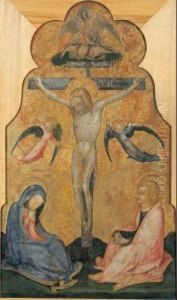Cristoforo Moretti Paintings
Cristoforo Moretti, a lesser-known figure in the vast panorama of the Italian Renaissance, was born in 1451, location unspecified, but likely in Italy, given the cultural and artistic movements he was part of. Details about his early life, including his family background and initial art education, remain obscure, largely due to the limited documentation and the overshadowing fame of his contemporaries like Leonardo da Vinci, Michelangelo, and Raphael. Despite this, Moretti managed to carve a niche for himself in the competitive art world of the 15th and early 16th centuries.
Moretti's work primarily revolved around religious themes, which was common among artists of his time, reflecting the deep intertwining of the Church with everyday life and the arts. He was proficient in fresco and tempera, and his style, while not revolutionary, displayed a competent grasp of the human form and an ability to convey religious narratives with emotion and devotion. His contributions, though not as widely recognized or celebrated as those of the leading figures of the Renaissance, add valuable depth to our understanding of the period's artistic diversity.
Surviving records indicate that Moretti was active in various Italian city-states, a common practice among artists seeking patronage and commissions. He may have been involved in some of the major artistic projects of the time, possibly in a collaborative or secondary role. However, specific works attributed to him have not been clearly identified or have been lost or attributed to more prominent artists, a not uncommon fate for artists of his stature during the Renaissance.
The date of Cristoforo Moretti's death is unknown, and like much of his life, it is shrouded in mystery. This lack of information has made it challenging for art historians to fully appreciate and evaluate Moretti's contribution to the Renaissance. Despite this, the collective efforts to piece together the lives and works of artists like Moretti underscore the ongoing interest in uncovering the full spectrum of creativity and innovation that characterized the Renaissance.
In summary, Cristoforo Moretti represents the many talented and yet underappreciated artists of the Renaissance, whose lives and works are partially hidden in the shadows of their more famous peers. His story is a reminder of the richness of this period in art history and the importance of continuing research and scholarship in bringing to light the contributions of those who have been overlooked.
